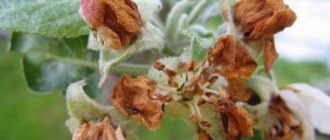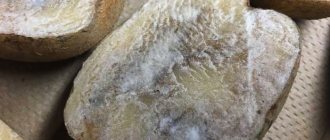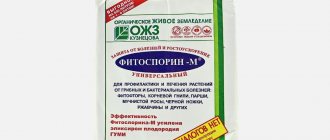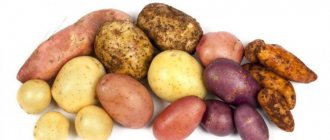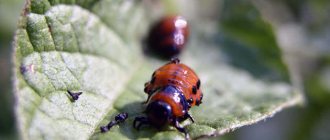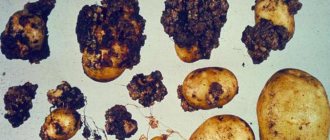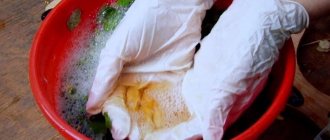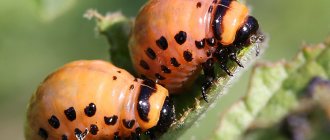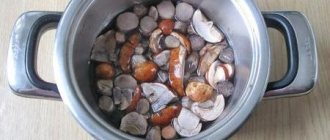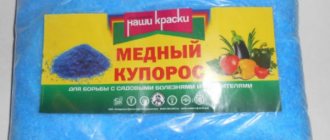Among the fungal infections that affect vegetable crops, late blight on potatoes, tomatoes, and other plants is considered the most insidious. Now we will talk about root vegetables. Over many years of experience in growing nutritious tubers, I have learned to cope with this scourge. Although it is not possible to completely eradicate the pathogen, prevention helps keep the disease in check. Under unfavorable conditions, the crop can be saved if treatment is started on time.
What is late blight and the causes of its occurrence?
Late blight is a common fungal disease of potatoes and other plants caused by mycelial organisms. The vegetable is affected by the fungus phytophthora infestans.
The incubation period of these pathogenic organisms is no more than two weeks, as a result of which the disease progresses rapidly. The mycelium is found in potato tubers that were previously affected by late blight.
The main sources of the disease:
- contaminated soil;
- remains of diseased plants (tops).
The optimal conditions conducive to the development of the disease are identified:
- temperature range +15-25 degrees;
- high humidity – more than 75%;
- dense planting of plants.
The pathogen spreads especially quickly in rainy times, with a sharp change in day and night temperatures, which is accompanied by the appearance of a large amount of dew and fog.
Hot weather is the enemy of the pathogen. Late blight spots dry out, the stems rejuvenate due to the fact that new healthy leaves grow. The fungus spreads extremely slowly at this time.
Late blight - what kind of disease is it, what affects
Late blight is a collective concept for many fungal diseases, the causative agents of which are mycelial organisms, lower fungi. In the process of their development, they adapt to a parasitic lifestyle and exhibit pathogenic properties on numerous plants - grass, trees, and shrubs.
Nightshade mushrooms are most often affected by fungi - potatoes, tomatoes, eggplants. But it is not uncommon for signs of the disease to appear on peppers, onions, strawberries, and cabbage. And you can even notice signs of disease on horseradish. The symptoms of the disease are the same in all cultures, but the disease is called differently in different cultures. For example, cucumbers, onions and cabbage have downy mildew, grapes have black spot or mildew, and potatoes have gray rot.
New genotype of late blight
The causative agent of the disease, which affected potatoes and was considered the only genotype for a long time, was introduced into European countries in the 19th century. At the end of the 20th century, new genotypes of late blight began to be discovered, which were called type A2.
Detection of A2-compatible isolates has become a significant problem, which is associated with the greater aggressiveness and virulence of microorganisms. The new fungus could easily develop under conditions that had a depressing effect on the old form.
The joint development of the local and new populations leads to the appearance of oospores in the affected potato tops. The latter have a thick two-layer shell, which ensures that they remain viable even in unfavorable conditions for a long time (about 4 years).
Oospores allow them to withstand low and high ambient temperatures and overwinter on tubers, tops remains, and in the soil. It was the emergence of a new genotype that determined a new route for the spread of fungi (previously, the soil could not be contaminated with pathogenic microorganisms for a long time).
The old form of the disease could affect potatoes only in the second half of the growing season. The new type is capable of infecting crops even in the germination phase.
Treating potatoes with fungicides
Funds in this group are divided into:
- Contact drugs are drugs that protect plants from infection, but are not capable of providing a direct therapeutic effect. They are only effective in the area where they are applied.
- Systemic - means that allow you to cure a plant, but only in the early stages of late blight development. The effect persists not only at the site of application, but also inside the plant.
- Systemic-contact - combined drugs that can have both preventive and therapeutic effects, penetrating inside the plant.
- Translaminar - agents that are able to penetrate plant tissue to a certain depth, but do not spread throughout the vascular system, which is typical for systemic drugs. This effect helps compensate for the uneven application of the fungicide to the surface of the plant.
Fungi of the Pythiaceae family easily develop resistance to fungicides that act inside the plant, but are usually always sensitive to those that act outside.
Contact fungicides
Contact fungicides that will effectively combat late blight on potatoes include:
- Anthracol - has a versatile effect, is used for late blight and alternaria on potatoes, and is washed off by precipitation. Treat 2-3 times with an interval of 7-10 days. 40 days before harvest, you should stop treating potatoes with this drug. Consumption of the drug – 2 kg per 1 ha.
- Copper sulfate and Bordeaux mixture (a mixture of copper sulfate in slaked lime). To spray potato tubers before planting, dilute 100 g of the drug per 10 liters of water. It is more convenient to put the planting material in a vegetable net and dip the potatoes into the solution.
- Shirlan is an effective preventive agent that has a long period of action of 7 days and is not washed off by precipitation. Usually 2, maximum 4 treatments with the drug are required. The first spraying is carried out when the plant reaches a height of approximately 20 cm, and the next spraying is carried out shortly before the potato tops begin to dry out. Product consumption is 0.3-0.4 liters per 1 hectare of garden.
Systemic fungicides
Among systemic fungicides, the most effective are:
- Fundazim is a product that has a protective, preventive and therapeutic effect. The preparation is used for dry treatment of tubers before planting at the rate of 20 g of product per 40 kg of potatoes.
- Quadris is a broad-spectrum fungicide used to suppress the pathogen when it first begins to manifest itself. Six milliliters of suspension are diluted in five liters of water. One hundred square meters of garden requires 5 liters of ready-made solution. The drug does not completely kill the fungus, which may require repeated spraying after a week.
Systemic contact fungicides
This group is represented by the following drugs:
- Ridomil Gold is the most effective and affordable remedy in our time. This is a combined fungicide that provides internal (Mefenoxam effect) and external protection (Mancozeb effect). It is better to carry out the first spraying prophylactically even before the potato tops close. Then carry out treatment every two weeks. There can be three such treatments per season. The solution is prepared as follows: 25 g of the drug is diluted with 10 liters of water. The solution consumption is 20-40 ml per square meter. m landing. Before harvesting, spraying is stopped (2 weeks before this event).
- Metaxil is a drug that has a long-term preventive and therapeutic effect (effective for 2 weeks). This fungicide is characterized by low phytotoxicity. Metaxil is a combination drug that contains Mancozeb and Metalaxil with contact and systemic action, respectively. The consumption of the diluted solution is up to 400 l/ha (this is about 2-2.5 kg of dry product per 1 ha). Usually they spray up to 3 times per season with a pause of 10-14 days.
Translaminar fungicides
This group can include 2 effective drugs:
- Thanos is also a combined remedy that has a healing effect. Thanks to Famoxadone, a film is formed on the surface of the plant leaves, which acts as a barrier. It is not washed off by rain or water during irrigation. Cymoxanil has an effect on many biochemical reactions that occur inside the fungus, which is why the latter does not develop resistance to the drug. The potatoes are sprayed 4 times (once at each stage of the growing season): closing of the tops, appearance of buds, end of their flowering, appearance of numerous green berries resembling tomato ovaries. For one spraying, a solution is consumed at the rate of 40 ml per 1 square meter. m.
- Acrobat is a translaminar fungicide whose active ingredients are dimethomorph and mancozeb. The drug is extremely effective, because the fungus is not resistant to it. One hundred square meters of land requires 20 g of the drug, which is dissolved in 5 liters of water. Spray a couple of times with an interval of 2 weeks. It is not recommended to spray a month before harvest.
Safety regulations
When using fungicides, despite the low toxicity of some, the following protective equipment should be used:
- special clothes;
- gloves;
- glasses;
- respirator.
If you work with Bordeaux mixture or copper sulfate separately, remember that the containers in which the product was prepared should not be used in the future for other needs. If a solution of one of these fungicides remains unused, get rid of it by burying it outside the garden or vegetable garden.
Preventive measures
Late blight on potato bushes can appear suddenly; to prevent this from happening, you need to take a number of preventive measures that will protect the tubers and tops from brown rot.
- In addition to the main factors, the development of fungal diseases is also influenced by the choice of planting site. When sowing potatoes, it is important to choose an area where there is no shade and moisture does not stagnate.
- Crop rotation of plants plays a significant role, since late blight mainly affects nightshade crops, therefore, planting potato roots in place of tomatoes, eggplants and other vegetables included in the nightshade list is strictly prohibited.
- Choosing healthy planting material and warming it up will get rid of spores in the tubers and give a good yield.
- Applying potassium fertilizers at an early stage of plant development will protect the plantings from brown rot.
- Hilling up seedlings has a beneficial effect on the sprouts and protects them from diseases.
- If weather forecasters promise that the end of the dacha season will end with prolonged rains, then it is better to dig up the crop and put it in a dry, dark place for ripening.
- After harvesting, it is important to dig up all the weeds and remove other debris from the site, which could serve as a source of infection for the next year.
By taking a number of preventive measures, your seedlings will be under reliable protection.
Fighting late blight using folk remedies
Among the most common means used to treat late blight on potatoes are:
- Trichopolum tablets - dissolve 1 dosage form of the drug in a liter of water and can spray the plants once every 2 weeks.
- Wood ash can be used not only as a preventative, but also as a therapeutic agent. As soon as the potatoes sprout, sprinkle ash between the rows. Repeat the action when the plant begins to bloom.
- Milk with iodine - dilute a liter of milk in 10 liters of water and add 15 drops of iodine. Spray the potatoes with the resulting solution every 2 weeks.
- Whey is an effective product that can be prepared by diluting the whey in water in a ratio of 1 to 1. This product is absolutely harmless to plants, which is why it can be used more frequently - once every 3-4 days.
- Infusion of garlic with potassium permanganate is a solution used for processing potatoes. To prepare for 10 liters of water, take 100 g of garlic and 1 g of potassium permanganate. Before preparing the solution, the garlic is crushed and poured with a glass of water, after which it is allowed to brew for 2 days. We filter the resulting infusion, dilute it with water and add potassium permanganate before spraying.
Hardy varieties
One of the effective measures to combat late blight is the use of potato varieties that are resistant to this disease for planting. These varieties include:
- Nevsky.
- Prestige.
- Spring.
- Onega.
- Arrow.
- Luck.
- Red Scarlet.
It should be borne in mind that planting late blight-resistant varieties does not provide a 100% guarantee of preventing late blight infection. To reduce the risk of this disease, it is necessary to take comprehensive preventive measures.
Other drugs and agents
Other drugs and remedies used for potato late blight include:
- Khom is a copper-containing preparation that is used as an alternative to Bordeaux mixture to protect potato plants during the growing season. It comes in the form of a green powder, which before use is dissolved in water and sprayed on plants. The drug "Hom" is treated up to 5 times with an interval of a month. The product is diluted in the following proportions: 20 g of powder per 5 liters of water. The solution consumption will be approximately 7 liters per 100 square meters. m landing.
- Alirin-B is a biological fungicide used for preventive purposes at any time during plant growth and before planting or when the first signs of fungal infection occur. The drug is characterized by low danger to humans, plants and the environment. It comes in the form of tablets, which are first dissolved in a small amount of water (10 pieces in 200 ml), and then this concentrate is poured into 10 liters of water. Also add 1 ml of laundry soap, previously soaked to a liquid state, to this solution so that the product sets better and remains on the leaves for a long time. Plants are sprayed at intervals of 10-12 days up to 3 times per season.
Three-fold potato processing scheme
As the name implies, in this method, planting is processed 3 times at different periods of plant development:
- From the emergence of seedlings to the closure of the tops in the row, Shirlan is used.
- From the closing of the tops to the opening of the buds - Ridomil Gold, Metaxil.
- From the appearance of flowers to the withering of the tops - Acrobat or Thanos.
Prevention methods
Prevention methods include several methods:
- choosing a landing site;
- use of disease-resistant potato varieties;
- treatment with special preparations (preventive).
Let's look at each method in more detail.
Selecting a location
It was previously stated that contaminated soil containing oospores is one of the possible causes of potato damage. It is best to choose a plain for planting.
If the site is located in a low area, then in these places the soil moisture is increased, and this means there is a high probability of disease development.
Other factors to consider include:
- soil looseness, good drainage flexibility;
- no shading of the area;
- increased distance between plantings of different nightshade crops (to avoid infection of all plants).
Experienced gardeners do not forget that the same crops cannot be grown in the same place for more than 5 years in a row.
Especially for potatoes, you can choose good predecessors, which can be:
- perennial herbs;
- winter crops;
- linen;
- beet;
- corn;
- mustard;
- radish.
Subsequently, the crops are mowed and buried in the soil.
Rotating potato plantings every couple of years will help significantly reduce the risk of late blight infesting nightshades. This system is called crop rotation. Read more about this here.
Resistant potato varieties
Among the varieties resistant to late blight are:
- Luck – characterized by early ripening of fruits. The tubers of this variety are large and resistant to many diseases.
- Reserve – medium early potatoes with small eyes. Tolerates drought and high moisture well.
- Timo is a high-yielding variety that is not infected with late blight due to its early ripening.
- Nidu is mid-season, resistant to late blight and nematode, but is quite picky about growing conditions (does not tolerate excessive moisture and drought).
- Blue is a potato variety with medium fruit ripening periods. It is characterized by high resistance to late blight and low temperatures.
- Lugovsky is a mid-season variety. When growing, it requires systematic hilling. Tubers can be stored for a long time.
- Zaryu is an early variety that is characterized by resistance to late blight, as well as to many viral and bacterial diseases.
- Nevsky - belongs to the mid-early potato. People often prefer the Nevsky variety because of the excellent taste of the tubers and the low amount of waste. In addition, these potatoes store well.
Treatment
It should be remembered that the use of contaminated seed guarantees 100% late blight disease. But how can we identify tubers affected by the pathogen? To do this, we warm up the planting potatoes for 2 weeks at a temperature of 16-17 degrees. Maintaining such conditions will allow you to notice the first signs of late blight and discard the affected root crops.
In the autumn, when planting material is selected, damaged tubers are burned rather than thrown away. Then we dry the potatoes and can safely store them in a convenient place.
To increase the resistance of the varieties we have selected, we can use fungicides and treatment preparations. Among these funds are:
- Immunocytophate;
- Agat-25K, etc.
Mineral fertilizers are also widely used as preventative agents. The amount of potassium and phosphorus substances increases by 2 and 1.5 times, respectively, at the beginning of crop development. Wood ash is a common fertilizing method used in addition to the above mineral fertilizers.
You should be careful when applying nitrogenous fertilizers, as in large quantities they cause a delay in the development of plant fruits, which makes potatoes increasingly susceptible to late blight and other ailments.
Other methods of prevention
People often help thicken potato skins by loosening the soil and mowing the tops. If there is not enough time to carry out these procedures, the drug “Reglon Super” is used, which has an identical effect.
Watering plants during drought or low temperatures is carried out only with a hose lowered into the furrows between the beds (it is not recommended to use the sprinkling method).
Crops affected by late blight should be removed and burned as soon as you notice them.
It is also worth promptly removing weeds that create favorable conditions for the development of the disease, becoming an ideal storage place for fungal spores or preventing the uniform application of fungicides to potato tops.
Causes of late blight in potato beds
Sometimes gardeners do not notice the moment when potato tops are affected by late blight. After all, pathogens from root crops located underground penetrate the stems from the inside through plant cells.
In this case, necrosis spots form in the lower part of the stems, on the lower rows of leaves. And healthy potato tubers become infected during the harvesting period, upon contact with infected tops and soil surface. The pathogen penetrates root crops through the eyes and areas of the fruit where the skin is missing.
If a potato is infected with late blight, then its spores will remain in the soil in the places where the affected tubers grew. Pathogens will live there for several years and gradually accumulate in large quantities.
They and the remaining undug tubers will become sources of infection of new seed roots planted in future years. Therefore, the main requirement of the rules of agricultural technology for growing potatoes and other representatives of the nightshade family is compliance with the order of planting vegetable crops. Potatoes are not planted on the same piece of land more than 2 years in a row.
Note! Damage to potato tubers by late blight begins at temperatures from 20 to 24°C, and Phytophthora spores multiply when the soil is heated from 12 to 18°C.
The most favorable periods for mass infection of potato fields with late blight are the rainy summer months, when frequent precipitation gives way to fog and heavy dew in the mornings.
Scheme of infection of potato bushes with Phytophthora spores
